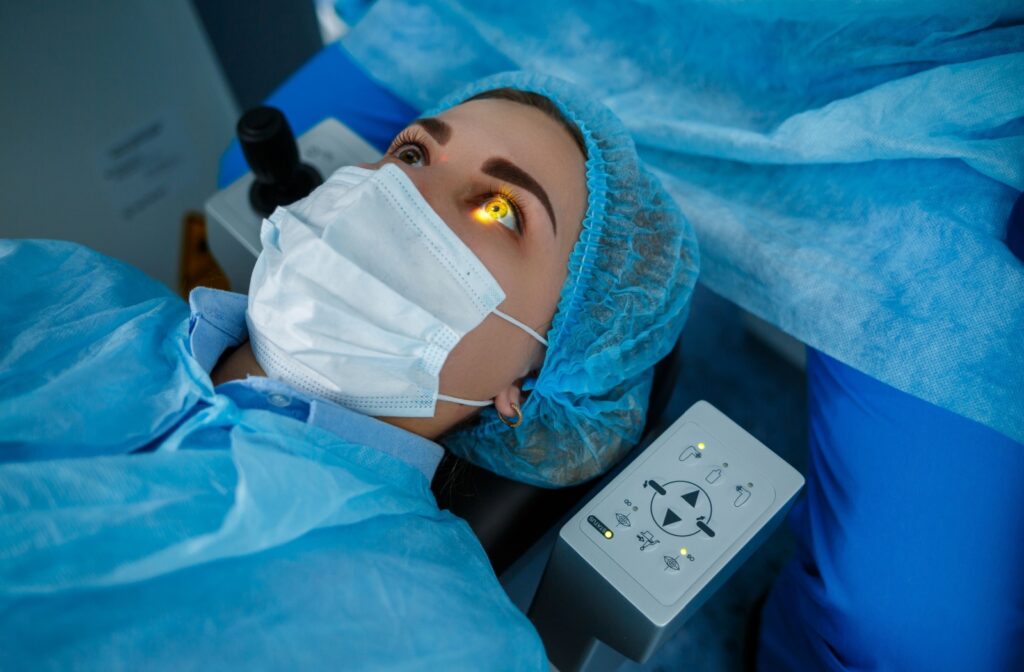For those wanting to improve their vision or seeking freedom from glasses or contacts, LASIK is a life-changing procedure.
This procedure improves vision by using specialized lasers to reshape the eye’s corneal tissue, altering its structure. However, this reshaping cannot prevent the onset of age-related visual changes or other concerns like LASIK regression.
While LASIK results cannot last forever, it can offer long-lasting results and undeniable everyday convenience.
All About LASIK
LASIK, short for Laser-Assisted in Situ Keratomileusis, is a widely performed laser eye surgery that’s gained immense popularity for its fast results, minimal downtime, and long-lasting improvements in vision.
This surgery uses a laser to reshape the cornea, improving refractive errors, and allowing light to focus on the retina, resulting in sharper vision.
LASIK offers impressive results for most patients but doesn’t guarantee perfect vision for everyone. Some may experience 20/20 vision, or better vision, significantly reducing or in some cases, eliminating the need for glasses or contact lenses.
How Does LASIK Work?
LASIK is an advanced ocular procedure and is performed by an ophthalmologist. Once inside the surgical room, the procedure is relatively quick, taking about 10 to 15 minutes per eye.
The procedure is relatively gentle, but knowing what to expect during the surgery can help encourage a comfortable headspace:
- Creation of the flap: The surgeon uses a laser to create a thin, hinged clap on the cornea’s outer layer. This flat is folded back to expose the underlying corneal tissue.
- Reshaping the cornea: Using another laser, precise amounts of corneal tissue are removed, reshaping it to correct the specific refractive error.
- Flap repositioning: After reshaping the cornea, the surgeon gently repositions the flap, which heals naturally over time without stitches. The flap acts as a protective barrier as the cornea heals.
Is LASIK for Everyone?
The everyday convenience of this procedure makes it an attractive option for many, however, not everyone is a good candidate for LASIK.
Certain eye conditions, eye characteristics, and health factors affect the procedure’s results. Some key parameters ophthalmologists consider when determining eligibility include:
- Stable prescription: Your vision prescription should be relatively stable for at least a year before surgery.
- Age: LASIK is generally recommended for adults aged 18 and older, though most surgeons recommend waiting until the mid-20s when prescriptions tend to stabilize.
- Corneal thickness: Those with thin corneas aren’t suitable for LASIK because there needs to be enough tissue to reshape the cornea safely.
- Overall eye health: Conditions such as severe dry eye, keratoconus, or other eye conditions may interfere with candidacy.
- Realistic expectations: It’s worth nothing for candidates to have realistic expectations of LASIK results. This surgery can greatly reduce the need for glasses or contacts, but may not eliminate the need for them entirely.

How Long Does LASIK Last?
One of the most common questions concerning LASIK is whether the results of the procedure last forever.
LASIK provides long-lasting vision improvement, but it’s worth noting these results may not last a lifetime. While the procedure reshapes the cornea, altering the structure of the eye, it doesn’t prevent the onset of natural changes or other vision concerns that can occur over time.
For most patients, LASIK provides excellent vision improvement that lasts for many years. One study found that approximately 90% of patients are satisfied with their vision results even a decade following the procedure.
Age-related concerns like presbyopia and cataracts can affect the procedure’s results, neither of which are linked to LASIK.
Presbyopia develops when the eye’s lens becomes less flexible, making it harder to focus on close-by objects, requiring the support of reading glasses. Meanwhile, cataracts develop when the eye’s natural lens becomes cloudy, causing blurry or hazy vision, which can be corrected with cataract surgery.
Alternatively, a small percentage of patients may experience regression, where the effects of LASIK partially diminish, leading to the return of mild refractive errors. If this change is noticeable and your ocular health can support it, correcting regression may be an option.
Aside from these changes, for many, LASIK results can remain stable for 10 years or longer.
Younger patients tend to experience longer-lasting results, as their eyes are less prone to age-related changes at the time of surgery. Still, everyone’s eyes and visual needs are unique, making it difficult to predict exactly how long the benefits will last.
Tips for Maintaining Your Vision
LASIK can significantly improve your vision, and maintaining its results requires ongoing care and attention. Here are some ways to keep your eyes and vision healthy and strong:
- Follow post-surgery guidelines: Carefully adhere to post-operative care instructions to promote ample healing and comfort. Use prescribed eye drops as directed, avoid touching and rubbing your eyes, and attend all follow-up appointments.
- Protect your eyes from UV rays: Unprotected exposure to ultraviolet rays can harm your eyes post-surgery and accelerate age-related vision changes. Wear sunglasses with 100% UV protection whenever you’re outdoors.
- Adopt a healthy lifestyle: Staying hydrated, eating a balanced diet rich in antioxidants and omega-3s, and regular physical activity help support overall eye health. Proper hydration helps reduce dry eye, a common concern after LASIK.
- Avoid excessive screen time: Prolonged time on digital devices can cause eye strain and dry eye. Take frequent breaks and follow the 20-20-20 rule, where every 20 minutes, look at something 20 feet away for at least 20 seconds.
- Avoid smoking: Smoking has been linked to various eye conditions, including cataracts and macular degeneration. By quitting smoking or avoiding exposure to secondhand smoke, you can reduce the risk of these conditions and help maintain the benefits of your LASIK surgery.
- Routine eye exams: Even after LASIK, routine eye exams are strongly recommended to monitor your vision and detect potential changes or issues early for timely management.
Schedule a Consultation
Ultimately, even if visual changes occur later in life, LASIK can significantly improve vision and reduce the need for glasses or contacts, especially during your younger years.
LASIK isn’t suitable for everyone, so visiting your optometrist helps verify whether this procedure is right for you.
Connect with our team at Advance Eye Care Centre to schedule your LASIK surgery consultation.





